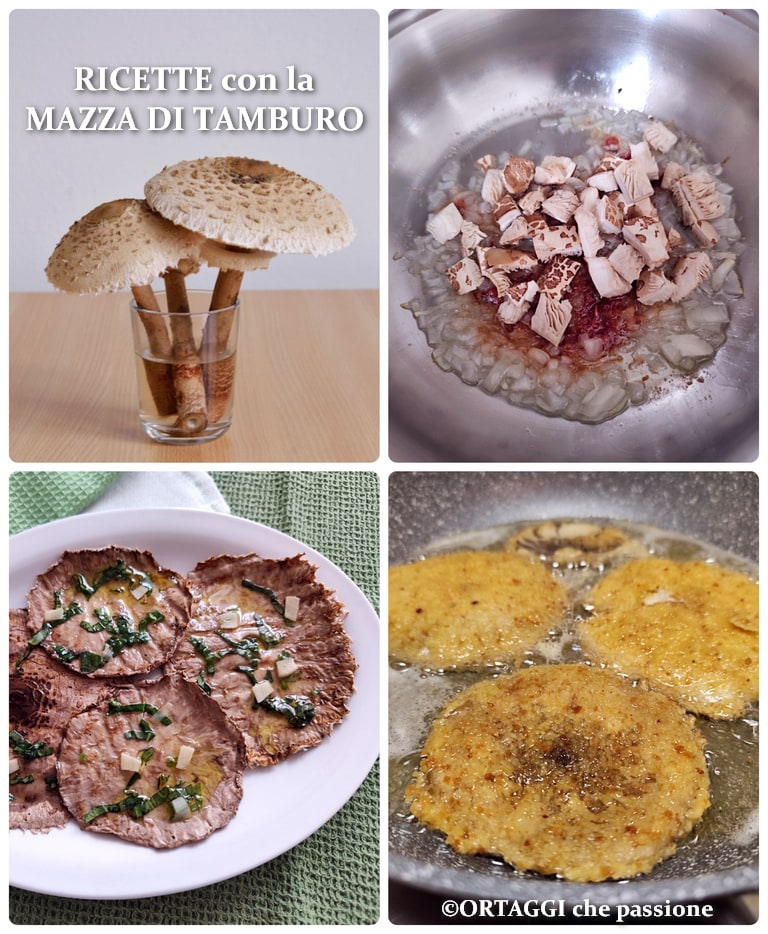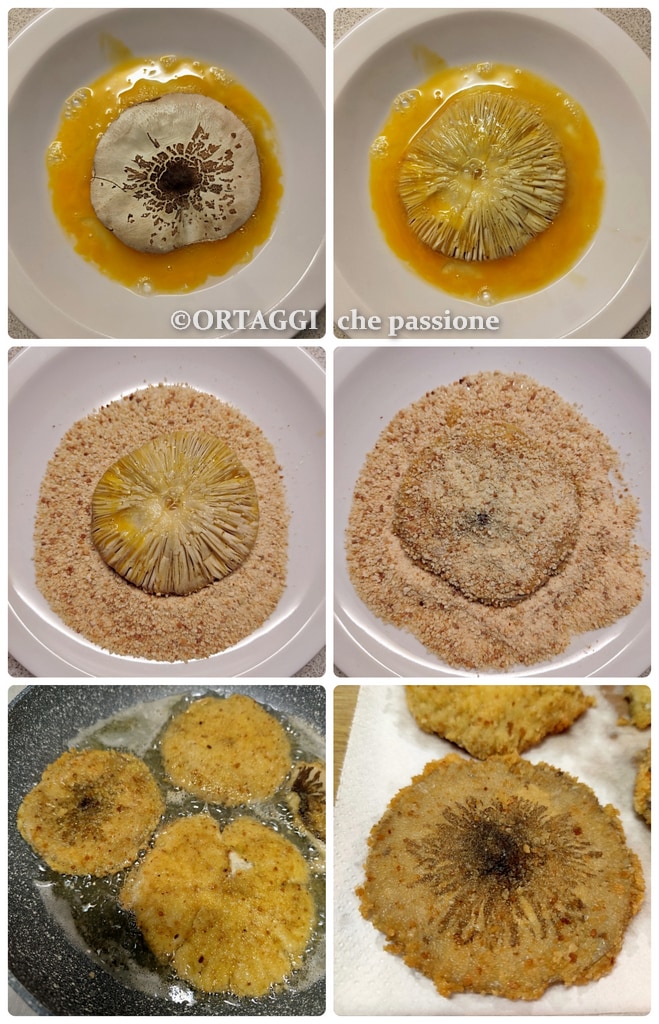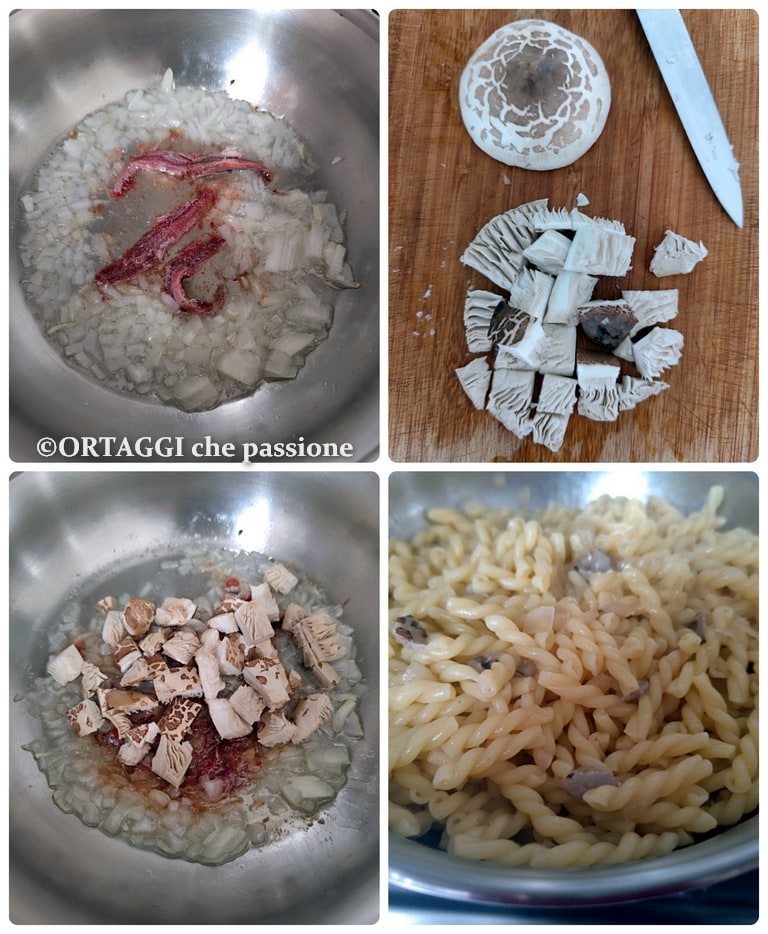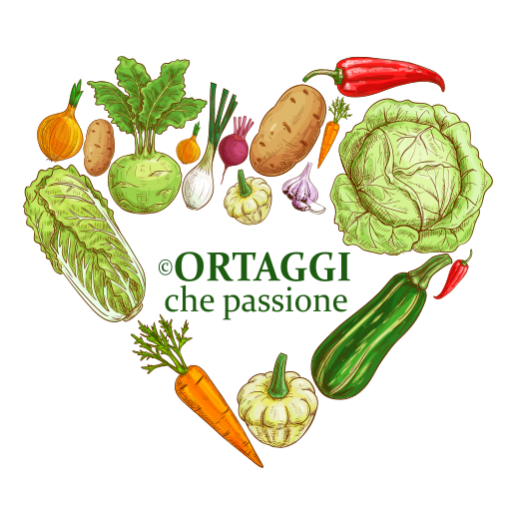The parasol mushroom is a highly prized edible fungus, known for its delicate flavor and versatility in the kitchen. Delicious when breaded and cooked in a pan, like a cutlet: the result is crunchy outside and tender inside, a perfect vegetarian main dish. If you’re in a hurry, a good alternative is to grill it: although it will lose a lot of water and become thin, the taste remains intact.
For a quick sauce, you can sauté it in a pan with a bit of onion and then make it creamy with some tomato puree: in a few minutes, you get a simple but tasty pasta seasoning. Finally, after a long day outdoors, you can enhance the soup or broth with chopped parasol mushrooms, adding a touch of flavor to the broth.
What is the difference between a good and poisonous parasol mushroom (or false)?
The good parasol mushroom (Macrolepiota procera, agaricus procerus, leucocoprinus procerus) and the poisonous one (Chlorophyllum molybdites) may look similar, but some key differences can distinguish them.
The good has a large whitish cap with light brown scales that tend to detach as it opens. The gills are white, dense, and wide, and with age, they can become pink or yellow. The stalk is slender, tall, woody, hollow, and has a white, sliding ring that lowers with the full opening of the mushroom’s cap. The flesh is white and does not change color when cut.
The poisonous has a whitish cap, the flesh stains red, the stalk is shorter, and the gills tend to turn greenish with age. It’s important to avoid picking mushrooms without being sure of their identification, as confusion can be dangerous.
When can parasol mushrooms be found?
The seasonality of these #mushrooms is from late summer to all of autumn. They can grow at any altitude and on any type of soil, even beyond 6562 feet, either alone or in small groups. It is easier to find them after heavy rains.
Other common names for parasol mushrooms: baruciola, bubbola maggiore, boigena, caloncia, conocchia, capela de prà, cappeddu de predi, cappellaccio, cappellone, cappellino, catuba, coppolino, crocola or crucola, cucumèla, fuliggina, umbrella mushroom, drumstick mushroom, gamba da pula, grucola, ombrellone, parasole, pavisciola, puppola, trulla, veloccia.
The nutritionist Emanuela Puca speaks: “Numerous studies have shown that “parasol mushrooms” have antimicrobial properties against various bacteria, including Bacillus cereus, Bacillus subtilis, and Proteus mirabilis. Additionally, they possess anti-inflammatory, immunostimulant, and antidepressant effects.
One of the main beneficial components of these mushrooms is 5-hydroxytryptophan, a substance our body uses to produce serotonin, a neurotransmitter linked to wellness and mood. The mushrooms also contain methionine, an essential amino acid. The quantities of these substances are higher in fresh mushrooms (up to 22.94 mg per 100 g), but decrease significantly when cooked. To preserve their nutritional value, it is recommended to cook them in a pan, boiled, or baked.
It is recommended to consume a maximum of 7 ounces per week. Thanks to their multiple beneficial properties, parasol mushrooms can also offer protection against various types of cancer and inflammations.”
RECIPES with mushrooms

- Difficulty: Easy
- Preparation time: 10 Minutes
- Portions: 2 People
- Cooking methods: Stove
- Cuisine: Well-being
- Seasonality: Autumn
- Energy 36.50 (Kcal)
- Carbohydrates 2.45 (g) of which sugars 1.49 (g)
- Proteins 2.32 (g)
- Fat 2.59 (g) of which saturated 0.37 (g)of which unsaturated 0.12 (g)
- Fibers 0.75 (g)
- Sodium 197.54 (mg)
Indicative values for a portion of 35 g processed in an automated way starting from the nutritional information available on the CREA* and FoodData Central** databases. It is not food and / or nutritional advice.
* CREATES Food and Nutrition Research Center: https://www.crea.gov.it/alimenti-e-nutrizione https://www.alimentinutrizione.it ** U.S. Department of Agriculture, Agricultural Research Service. FoodData Central, 2019. https://fdc.nal.usda.gov
Parasol Mushroom RECIPES
How many parasol mushrooms can you eat? There is no fixed number of parasol mushrooms you can eat, but it’s advisable to consume this mushroom in moderation to avoid digestive issues, especially if it’s your first time. It’s better to start with a small amount and always cook it well.
In nature, parasol mushrooms come in all sizes, from small ones (even under 2.75 inches in diameter) to giant ones that can reach even over 15.75 inches in diameter.
- 2 parasol mushrooms (or Pleurotus mushrooms)
- Half tablespoon extra virgin olive oil
- to taste salt (and chosen spices: garlic, basil, chili pepper, parsley…)
CLEANING THE PARASOL MUSHROOMS
HOW TO CLEAN
Remove the hollow stem of the umbrella mushroom (grab the cap and twist the stem gently to perfectly extract the final and high bulb of the stem) and only if necessary, quickly rinse them under running water. To clean them, just remove the dirt or other debris with a slightly wet cloth, it’s better to avoid wetting them to prevent losing flavor and filling them with water.
Note: the stem is woody and indigestible, absolutely avoid consuming it.
Grilled parasol mushroom
Dry the parasol mushrooms, then heat a grill. Grill the caps until they are well browned on both sides. Add a drizzle of oil, a pinch of salt, and if desired, some parsley and chopped garlic (alternatively basil and/or chili pepper).
Read at the bottom for the nutritionist’s opinion.
Tools
- Grill Pan non-stick
- Pan wide and low steel
Pass the cleaned caps, optionally first in flour, then in beaten egg, and finally in breadcrumbs. Fry in hot oil until golden brown. Drain on absorbent paper and serve hot.
Alternatively, use for a parmigiana with parasol mushrooms instead of eggplants.
AIR FRYER COOKING
Place the mushroom cutlets on parchment paper and spray oil on top. Then, place in the fryer and cook at 374°F for about 10 minutes, turning halfway through and spraying more oil on top.

Cook in a pan over low heat with a drizzle of oil, garlic, and salt. Turn halfway through cooking and before serving, flavor with fresh parsley.
Clean the mushrooms and arrange them on a baking sheet. Season with oil, salt, pepper, and aromatic herbs. Bake at 356°F for 20-25 minutes, until tender and golden. Serve hot.
1st method
Cook the caps in a pan with oil, garlic, and tomato. Add salt, oregano, and optionally capers. Then, if desired, add pieces of mozzarella (or julienned, grated parmesan) and continue cooking until the mushrooms are tender and the cheese is melted.
2nd method
First, bread the mushrooms and fry them in a pan. Subsequently, season the center of the fried parasol mushrooms with tomato sauce and mozzarella. Bake until the mozzarella melts over the mushrooms.
Make a sauté with onions and anchovies (alternatively with garlic), cut the mushrooms into pieces and brown them. If desired, add tomato puree, salt and cook for a few minutes.
Use the sauce to season pasta.

First, fry the caps of the parasol mushrooms (as described above), then place them in a baking dish. Add tomato sauce, mozzarella, and grated cheese. Bake until the cheese is melted and golden. Serve the parasol mushroom parmigiana hot.
Peel and slice the potatoes thinly. Arrange them in a baking dish with oil, salt, and rosemary. Add the cleaned parasol mushrooms and bake everything until the potatoes are golden and crispy. Serve hot.
Boil the caps of the parasol mushrooms in boiling water with a little vinegar for about 10 minutes.
Then, drain and let dry. Then season with extra virgin olive oil and salt.
How to cook not fully open parasol mushrooms
– the closed small cap can be fried like a small egg
– the semi-open cap can be filled and cooked in a stew
FAQ (Questions and Answers)
How to store fresh parasol mushrooms?

Parasol mushrooms are stored with the stem immersed in water, just like flowers. If you have picked a still closed parasol mushroom, immerse it in a glass of water for half a day, so it will open and be ready to be cooked.
Note: the parasol mushroom tends to shed many spores, so you might find a white veil of spores on the surface where you’ve kept it.What is the price per kg of parasol mushrooms?
The price per kg of parasol mushrooms can vary based on availability, season, and area where it is picked. Generally, the cost ranges between 10 and 20 euros per kilogram. It’s advisable to check local markets or mushroom gatherers to have a more precise idea and update yourself on the prices.
BENEFITS of parasol mushrooms
The nutritionist Emanuela Puca speaks:
Numerous studies have shown that “parasol mushrooms” have antimicrobial properties against various bacteria, including Bacillus cereus, Bacillus subtilis, and Proteus mirabilis. In addition to this, they possess anti-inflammatory, immunostimulant, and antidepressant effects.
One of the main beneficial components of these mushrooms is 5-hydroxytryptophan, a substance our body uses to produce serotonin, a neurotransmitter linked to wellness and mood. The mushrooms also contain methionine, an essential amino acid. The quantities of these substances are higher in fresh mushrooms (up to 22.94 mg per 100 g), but decrease significantly with cooking. To preserve their nutritional value, it is recommended to cook them in a pan, boiled, or baked.
It is recommended to consume a maximum of 7 ounces per week. Thanks to their multiple beneficial properties, parasol mushrooms can also offer protection against various types of cancer and inflammations.

